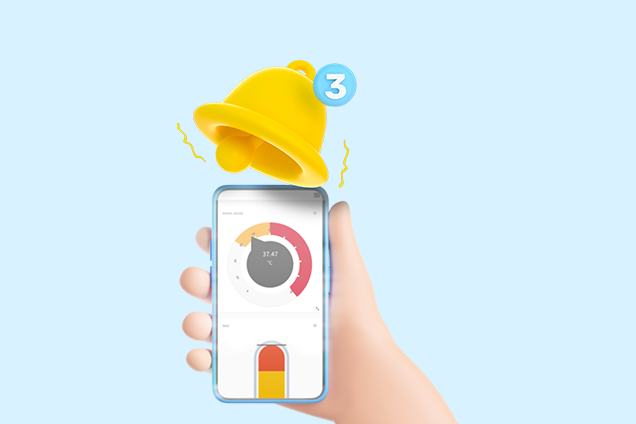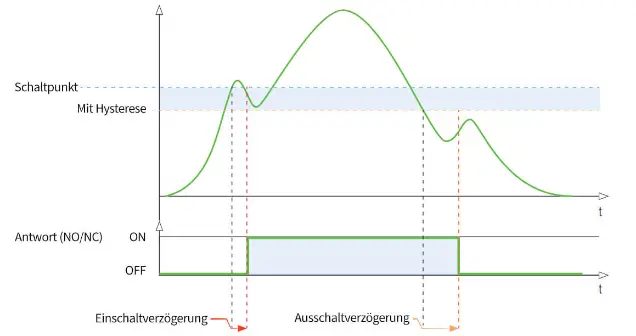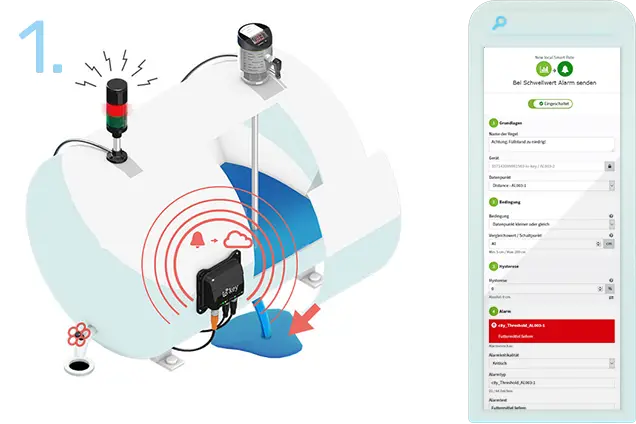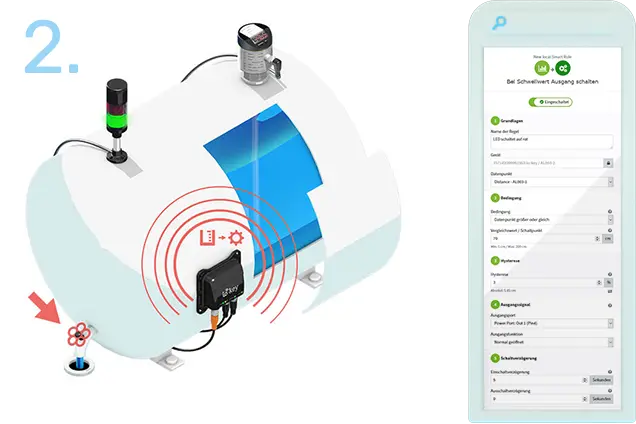Edge alarm & switching function
Edge alarm function
Monitor limit values in real time
With io-key®, you can monitor the production, process or application in real time. As soon as a limit violation is detected, io-key® sends an alarm to the cloud. This has two advantages:
1. Reduced costs: Not all data is transmitted to the cloud and stored there. Often it is not necessary to have all your data in the cloud; only the relevant information is needed.
2. Immediate notification when a limit value is exceeded. Regardless of the selected transmission interval, io-key® transmits the limit value violation directly to the cloud as a push message. An alarm can be generated here, which results in further actions (e.g. email dispatch, text notification dispatch, analytics rule, SAP action, ...).
The edge alarm function can be used both in case of a limit value violation (greater or less than) and with a window function. If the sensor value is inside or outside the window, depending on the configuration, an alarm is sent to the cloud.
The edge alarm function is set conveniently and centrally managed from the cloud. Parameters such as threshold value, hysteresis, alarm severity and text can be assigned individually. Screenshot with settings in the cloud.


Thanks to the edge alarm function, you will never miss an important event again. This is how you turn data into relevant information. That's what IIoT is all about.
Rainer Schniedergers, Authorized signatory/CTO at autosen


Edge switching function
Replace the PLC with io-key®
Use the io-key® edge switching functions to switch up to two digital outputs in real time directly at the device, independently of the cloud. For this purpose, a configuration is stored directly on your device.
Regardless of the selected transmission interval, the edge switching function runs autonomously on io-key® and permanently monitors the process or application. io-key® thus replaces a PLC and enables direct addressing of actuators (e.g. stack lights or acoustic signals). Wiring is possible using a simple Y-cable and is easy to perform.
In the respective cloud account, it is possible to set the condition under which a switching output is changed directly on io-key®, regardless of the applied transmission interval. To do so, set the rule (e.g. limit value greater than X, limit value less than X) before selecting the switching output that is to be changed on io-key® as soon as the limit value has been reached. Furthermore, a hysteresis as well as a switch-on/ switch-off delay can be set. As soon as the set limit value has been reached or exceeded, the output function at the set output changes.

Two application examples
Remote tank system monitoring with io-key®
io-key® collects and transmits sensor data for further processing in an individual cloud and software environment. A new feature is that it can also execute alarms and switching operations directly at the machine independently and in real time. This makes it possible to create complete end-to-end applications for IIoT without a complex and expensive infrastructure – the use of a PLC is no longer necessary.

Alarm for leakage or critical level
If the level drops below a critical level, tank leakage is to be assumed. The change in process values is registered by io-key® in real time and an alarm is triggered immediately after a limit value is exceeded, which sends an alarm to the cloud regardless of the selected data packet, in this case one hour. It is processed there and can be further distributed via various media channels. At the same time, a switching output which supplies an LED signal tower with power is activated at io-key® when a limit value is exceeded. A local optical and acoustic alarm signal can be easily generated directly at the edge, which makes it easier to locate the system with a critical condition, especially in complex production plants.
Overview of the io-key® edge alarm function:
1) Basics: The name of the rule can be assigned individually.
2) Condition: The limit value and the comparison value are set.
3) Hysteresis: The hysteresis is used to avoid unwanted false alarms.
4) Alarm: The severity of the alarm and its text can be assigned.

Edge valve control at a critical filling level
If the tank reaches a critical filling level, the level sensor registers this and an alarm is immediately triggered at io-key®, which is indicated by the message "Tank system: Critical filling level reached. Valve opened" in the autosen.cloud.
At the same time, a switching output is activated at the edge, which opens the electric valve to initiate the discharge of water and activates the red status indicator. When the tank is almost empty, the valve is closed by io-key® and the green LED lights up again. The flow sensor reports the flow rate in the cloud and notifies the production management about this process.
The io-key® edge switching and alarm function is conveniently controlled from an office without the need for any programming. All the necessary parameters are defined via a graphical interface in the autosen.cloud from anywhere in the world, stored locally at the edge and executed independently of the wireless connection.
Overview of the io-key® edge switching function:
1) Basics: The name of the rule can be assigned individually.
2) Condition: The switching rule and the switch point are set.
3) Hysteresis: The hysteresis refers to the difference between the switch point and the switch-back point.
4) Output signal: The output port and its output function are selected.
5) Switching delay: The switching signal can be delayed with this function.

Need help creating alarm or switching functions?
We are happy to help you. We are available in person from Monday to Friday from 08:00 - 17:00 (CET) or flexibly via our contact form. Alternatively, you can visit the io-key® Helpcenter.
Contact us! Learn more in the help center



